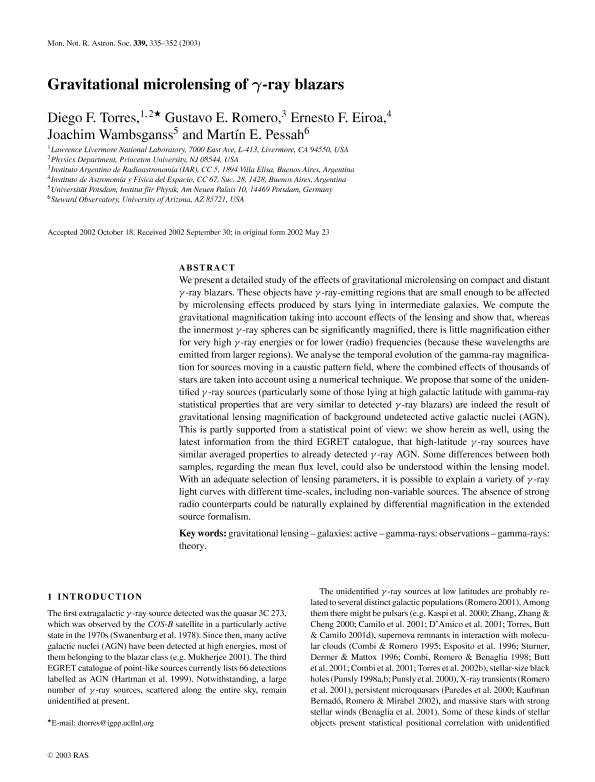Mostrar el registro sencillo del ítem
dc.contributor.author
Torres, Diego F.

dc.contributor.author
Romero, Gustavo Esteban

dc.contributor.author
Eiroa, Ernesto Fabian

dc.contributor.author
Wambsganss, Joachim
dc.contributor.author
Pessah, Martin E.

dc.date.available
2017-12-18T17:04:34Z
dc.date.issued
2003-12
dc.identifier.citation
Pessah, Martin E.; Wambsganss, Joachim; Eiroa, Ernesto Fabian; Romero, Gustavo Esteban; Torres, Diego F.; Gravitational microlensing of gamma-ray blazars; Wiley Blackwell Publishing, Inc; Monthly Notices of the Royal Astronomical Society; 339; 12-2003; 335-352
dc.identifier.issn
0035-8711
dc.identifier.uri
http://hdl.handle.net/11336/30880
dc.description.abstract
We present a detailed study of the effects of gravitational microlensing on compact and distant γ -ray blazars. These objects have γ -ray-emitting regions that are small enough to be affected by microlensing effects produced by stars lying in intermediate galaxies. We compute the gravitational magnification taking into account effects of the lensing and show that, whereas the innermost γ -ray spheres can be significantly magnified, there is little magnification either for very high γ -ray energies or for lower (radio) frequencies (because these wavelengths are emitted from larger regions). We analyse the temporal evolution of the gamma-ray magnification for sources moving in a caustic pattern field, where the combined effects of thousands of stars are taken into account using a numerical technique. We propose that some of the unidentified γ -ray sources (particularly some of those lying at high galactic latitude with gamma-ray statistical properties that are very similar to detected γ -ray blazars) are indeed the result of gravitational lensing magnification of background undetected active galactic nuclei (AGN). This is partly supported from a statistical point of view: we show herein as well, using the latest information from the third EGRET catalogue, that high-latitude γ -ray sources have similar averaged properties to already detected γ -ray AGN. Some differences between both samples, regarding the mean flux level, could also be understood within the lensing model. With an adequate selection of lensing parameters, it is possible to explain a variety of γ -ray light curves with different time-scales, including non-variable sources. The absence of strong radio counterparts could be naturally explained by differential magnification in the extended source formalism.
dc.format
application/pdf
dc.language.iso
eng
dc.publisher
Wiley Blackwell Publishing, Inc

dc.rights
info:eu-repo/semantics/openAccess
dc.rights.uri
https://creativecommons.org/licenses/by-nc-sa/2.5/ar/
dc.subject
Gravitational Lensing
dc.subject
Active Galaxies
dc.subject
Gamma Ray Observations
dc.subject
Gamma Ray Theory
dc.subject.classification
Astronomía

dc.subject.classification
Ciencias Físicas

dc.subject.classification
CIENCIAS NATURALES Y EXACTAS

dc.title
Gravitational microlensing of gamma-ray blazars
dc.type
info:eu-repo/semantics/article
dc.type
info:ar-repo/semantics/artículo
dc.type
info:eu-repo/semantics/publishedVersion
dc.date.updated
2017-11-16T14:44:06Z
dc.journal.volume
339
dc.journal.pagination
335-352
dc.journal.pais
Reino Unido

dc.description.fil
Fil: Torres, Diego F.. Lawrence Livermore National Laboratory;
dc.description.fil
Fil: Romero, Gustavo Esteban. Provincia de Buenos Aires. Gobernación. Comisión de Investigaciones Científicas. Instituto Argentino de Radioastronomía. Consejo Nacional de Investigaciones Científicas y Técnicas. Centro Científico Tecnológico Conicet - La Plata. Instituto Argentino de Radioastronomía; Argentina
dc.description.fil
Fil: Eiroa, Ernesto Fabian. Consejo Nacional de Investigaciónes Científicas y Técnicas. Oficina de Coordinación Administrativa Ciudad Universitaria. Instituto de Astronomía y Física del Espacio. - Universidad de Buenos Aires. Facultad de Ciencias Exactas y Naturales. Instituto de Astronomía y Física del Espacio; Argentina
dc.description.fil
Fil: Wambsganss, Joachim. Universitat Potsdam; Alemania
dc.description.fil
Fil: Pessah, Martin E.. University of Arizona; Estados Unidos
dc.journal.title
Monthly Notices of the Royal Astronomical Society

dc.relation.alternativeid
info:eu-repo/semantics/altIdentifier/doi/http://dx.doi.org/10.1046/j.1365-8711.2003.06219.x
dc.relation.alternativeid
info:eu-repo/semantics/altIdentifier/url/https://academic.oup.com/mnras/article/339/2/335/1004147
Archivos asociados
